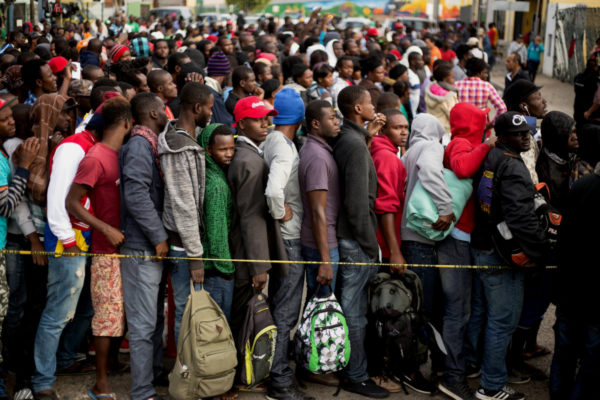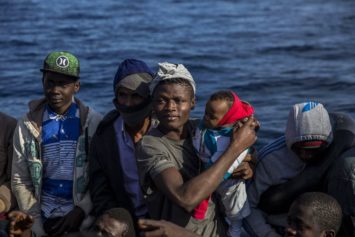
(Photo: Guillermo Arias/AFP/Getty Images)
The subject of migrants at the U.S.-Mexico border conjures images of people from Latin America, particularly Central America, who are fleeing poverty and violence. However, the dynamics of migration into the U.S. are changing. Increasingly, many migrants crossing the border are from nations in Africa and the Caribbean, particularly Haiti, making asylum seekers and the border a Black issue as well.
In June, U.S. authorities intercepted a record number of African migrants and refugees at the border with Mexico, as Foreign Policy recently reported. There are two factors involved with this new trend. On the one hand, hundreds of Black people are traveling from nations as far away as the Democratic Republic of the Congo, Eritrea, Somalia and Sudan, escaping violence in their home nations and emerging in South America by sea, air and foot, and making the dangerous journey through Colombia and Panama en route to America.
On the other hand, Europe has experienced a dramatic decline in the influx of African people. Both phenomena–the increase in Africans crossing the U.S.-Mexico border, and the simultaneous drop in Africans making their way to Europe– are attributed to a new policy adopted by the European Union in 2018 which made Libya the primary center for processing applications from asylum seekers and refugees attempting to cross the Mediterranean to Europe via North Africa. Many Africans have drowned while trying to cross the sea to enter Europe. Rather than take their chances and make their way through Libya, where many have perished, migrants are increasingly opting for the much longer and costlier route taking them thousands of miles through South America and ultimately the U.S. Like their Central American counterparts, many African refugees are travelling in families in the hopes of facilitating their entry.
In Nuevo Laredo, Mexico, across the border from Laredo, Texas, 1,500 West Africans and Central Americans find themselves in an asylum holding pattern. At a makeshift refugee camp in the city of Ciudad Acuña, Mexico —across the border from Del Rio, Texas, along the Rio Grande — asylum seekers are in limbo as Trump restricts their entry, in violation of what immigrants’ rights advocates say is their legal right to seek asylum. According to the Los Angeles Times, 15,000 refugees wait at the border, while another 15,000 were returned to Mexico after crossing the border. U.S. Border Patrol agents have arrested 40,000 people from 50 countries this year, including those of African, Haitian, Cuban, Central American and South American origin, and a rapidly increasing number of Indian and Bangladeshi origin. In June, a 6-year old girl from India died of hypothermia at the border in 108 degree heat.
Mexican officials have encountered 3,000 African migrants in 2018 and 2,000 this year to date, with Cameroon, Congo and Angola as the chief countries of origin. Africa has endured a refugee crisis in which its people have died and faced racist treatment. In 2018, people from the Congo accounted for the third-largest group of new refugees in the world at 123,000, with Cameroon having 447,000 new refugees, according to the U.N. Refugee Agency. Primarily African developing nations take in 80 percent of the global refugee population, which strains these countries’ health care and water systems. Trump’s decision to cut aid to African nations, particularly those with large numbers of refugees, may exacerbate the world refugee crisis by fueling the conflicts that make migration necessary, notes The Intercept.
According to a report from the Black Alliance for Just Immigration (BAJI), the face of migration is changing. People from the Caribbean are the largest group of migrants crossing the U.S.-Mexico border other than migrants from Central America and Mexico. BAJI notes the 7.0 magnitude earthquake that hit Haiti in 2010 — leaving 300,000 injured and as many as 316,000 dead — was a leading cause of the migration of Haitians. Nearly 7,000 Haitian immigrants live in a number of Mexican border towns, and “19,000 African and Haitian migrants arrived in Mexico in 2016 and up to 700 a day were arriving in Tapachula, Mexico in that same year.”
Last year, over 3,000 Haitians went to Tijuana, Mexico, in the hopes of making it to the U.S. Many stayed and formed a community there after facing a protracted asylum process. Facing pressure to reduce the flow of migrants into the U.S., and threats from President Trump to impose tariffs on its imports, Mexico returned 81 migrants to Haiti in June after several attempted to flee the airplane during an uprising at the airport in the southern state of Chiapas. Also that month in Chiapas, home to the largest detention facility in Mexico, hundreds of Haitian and African migrants rose up and attempted to flee their harsh conditions. Black people detained in Mexico have complained of vermin, abuse from guards, a lack of food and medical care, and cramped living conditions in which 50 people sleep in rooms only 9 feet by 12 feet.
Regarding refugees from Central America, BAJI notes that in one year, 70,000 accompanied minors crossed the U.S.-Mexico border “fleeing environmental harm, oppressive governmental regimes sponsored by the U.S., the transnational war on drugs, and a number of other life threatening conflicts.” Although the number of Black migrants from Central America is unknown, the Black immigration advocacy group believes many of these migrants are members of the Afro-indigenous Garifuna people, who have struggled with land grabs, drug trafficking and environmental devastation. Darlin Suazo — a Black mother from Honduras who was detained for two months and separated from her child — described her harrowing experiences in ICE custody in what is known as the “dog kennel” and the “walk-in freezer.”
BAJI believes a holistic approach is required to support Black refugees and their advocates at the border. Examples of what is needed include funding for Black immigration and refugee organizations; facilitating Black leadership at the border; ensuring that larger border organizations serve Black migrants; African-language and Creole interpreters, and culturally competent lawyers. Black lives matter at the border.


